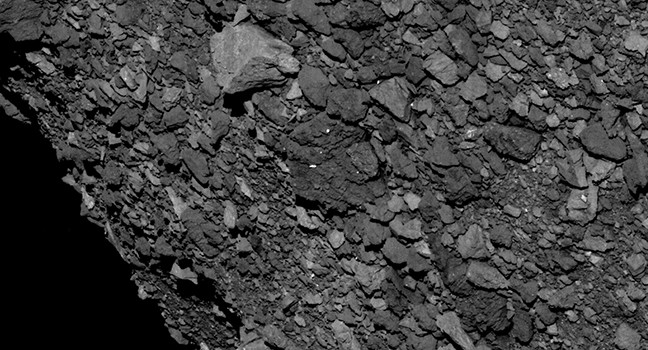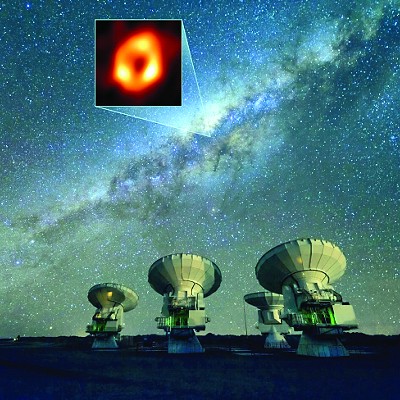Since arriving on Dec. 3, 2018, the OSIRIS-REx spacecraft has orbited the asteroid Bennu more than a dozen times. In this period, researchers at NASA and the University of Arizona have examined the surface and composition of the 1,614 ft. asteroid, answering some questions and creating many more.
OSIRIS-REx is a NASA and UA asteroid study and sample-return mission. Launched September 2016, the goal is for the spacecraft to collect a sample of dust and rock from Bennu, aiding research on the history of our solar system and life on Earth. It is expected to return with its sample in September 2023.
The involved scientists recently published the largest collection of information gathered from this mission thus far, a series of eight scientific papers across several journals. Here are five key findings:
Bennu's surface is rougher
than expected. Possibly the most important announced discovery is the roughness of Bennu's surface. Scans reveal Bennu is "packed with more than 200 boulders larger than 33 feet (10 m) in diameter and many more that are 3 feet (1 m) or larger. The largest boulder measures 63 yards (58 m) across." This is a far cry from the originally expected surface of gravel and pebbles. This complicates the original plan for the spacecraft to collect its sample; instead of having roughly half a football field to navigate in, OSIRIS-REx will have to collect a sample in a site half the size of a basketball court or smaller.
"Despite these newly found challenges, our team is confident that we will meet the science objectives," said Dante Lauretta, OSIRIS-REx principal investigator and UA professor of planetary science. "The OSIRIS-REx team designed the mission with flexibility and capabilities to deal with the unknown, and we are prepared to answer the challenges Bennu has given us."
Bennu is one of the darkest
objects in the solar system. High resolution images shot with OSIRIS-REx's multiple cameras reveal Bennu reflects only 4 percent of sunlight. This is due to Bennu being a carbonaceous asteroid, meaning its composition includes a large amount of naturally dark carbon. However, researchers also found Bennu's surface to possess a higher-than-expected variety of albedo, or solar reflection. Meaning the brightness of Bennu's surface varies greatly from one area to the other, due to the rough surface. This presents an unexpected challenge for the spacecraft's laser scanning system, or lidar.
"We did not predict the varied albedo," said OSIRIS-REx Science Team lead Michael Nolan. "... bright spots could confuse the lidar, but they make navigating by visual landmarks much easier, as computer algorithms can more easily find odd-shaped bright rocks on a dark background than subtle terrain changes."
Bennu is a rubble pile.
With a "spinning-top shape" already known before arrival, Bennu's surface is older than expected, but shows evidence of recent activity. Scientists describe this as a "dynamic surface," formed from multiple collisions with smaller asteroids. Bennu also contains a lot of empty space, up to 60 percent, but its shape indicates interior stiffness, with enough internal strength to allow the surface to crack.
"The ruggedness of the terrain was certainly something we thought possible, though there are definitely more large rocks than we expected," Nolan said. "We did not really expect the rockiness to be quite so uniform over the surface based on data from other missions. Now we are studying the surface to select areas that are both free of large hazards and that have material small enough to sample—essentially coarse gravel. We have identified quite a few potential sites that we are studying in more detail."
Bennu has water in its past.
The first scientific data returned from the OSIRIS-REx mission was visible and infrared imaging that revealed hydrated minerals on Bennu's surface. For hydrated minerals to be formed, they must come in contact with water at some point in the past. Hydrated minerals are "ubiquitous across the surface of the asteroid," and while Bennu is too small to have ever hosted liquid water, the finding indicates liquid water was present at some time on Bennu's parent body, a much larger asteroid.
"These hydrated minerals have evidence of liquid water in Bennu's past," said Amy Simon, Deputy Instrument Scientist for OSIRIS-REx. "It's one of the things we were hoping to find... we're super excited."
Bennu is spinning faster.
Bennu's rotation is steadily accelerating at about one second per century. This increase is due to the YORP effect, where differences on the surface of a small astronomical body unequally scatter solar radiation. Due to Bennu's aforementioned roughness and variety of albedo, it is catching and reflecting sunlight at different angles, causing its rotational rate to drift. Researching this phenomenon is one of the original goals of the OSIRIS-REx mission.
These findings are in several Nature Publishing Group journals. With the sample acquisition planned for July 2020, there is still ample time for more scientific observation and discovery at the asteroid.
"We don't have a detailed schedule for future publications: We worked hard to get an initial batch of information out as soon as we could (that is, last week), but future papers are likely to be less scheduled," Nolan said. "There are several papers already in work."














